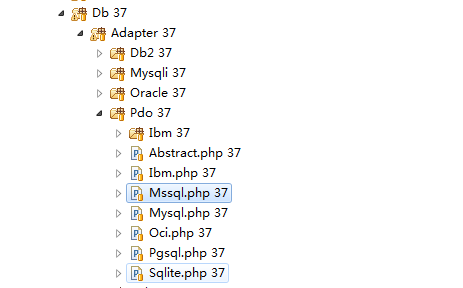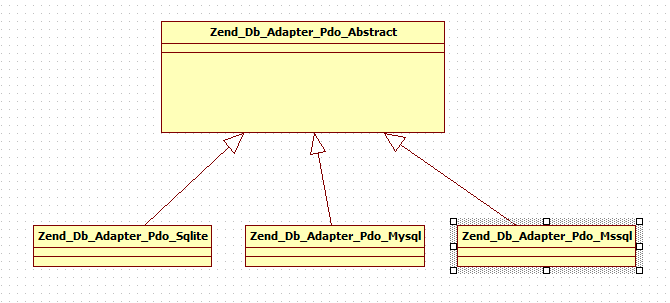Home >Backend Development >PHP Tutorial >Zend Framework中的简单工厂模式 图文_php技巧
Zend Framework中的简单工厂模式 图文_php技巧
- WBOYWBOYWBOYWBOYWBOYWBOYWBOYWBOYWBOYWBOYWBOYWBOYWBOriginal
- 2016-05-17 09:10:26851browse
前段时间用来ZF,把他当黑盒感觉不是很好,一直有看其源码的冲动,但是。。。如果一点一点点看的话,挑战确实有些大了。某天又然后想到好久没复习设计模式了。综合一下,复习一个设计模式之后在ZF中找一下使用这模式的源码吧,不读所有源码,读读比较”高级”的部分吧,要说模式,暂时不知道是不是所有模式ZF里面都有,但是应该有足够的模式够我最近看了,在说可以找找其他开源的软件来找模式。这段时间被各种笔试神马乱七八糟的把生活搞得稍微有点乱,但是不管怎样,复习还是必须的吧。再说一下ZF吧,ZF一个好处就是各个component比较独立,component之间没有过多的依赖,这样一来,为使用者提供了方便,当然也为我这样无聊且懒的想看源码的人提供了方便。
今天看看简单工厂,ZF里面不缺模式,更不缺工厂模式,大名鼎鼎的的 Zend_Db就毫不吝啬的使用简单工厂,再ctrl+h(zend studio下)一下会发现factory特别多,如果没猜错应该大多应该也是简单工厂。由于Zend_Db 最常用,我也就自然的会比较想看一下他的实现。在查看源码之前先复习一下怎么用Zend_Db和简单工厂(这里是一个stack,先复习简单工厂)。
复习简单工厂模式
用类图回忆一下,简单工厂类图:

1.复习Zend_Db的使用
如果不知道如何使用,准备看XXX的源码却不知道怎么用XXX,这有点囧,所以先小小的看一下Zend_Db的使用,下面这段是在ZF官方文档里面的(个人不是很喜欢ZF文档,没Yii易读)
/public/index.php
复制代码 代码如下:
$db = Zend_Db::factory('Pdo_Mysql', array(
'host' => '127.0.0.1',
'username' => 'webuser',
'password' => 'xxxxxxxx',
'dbname' => 'test'
));
这里是把数据库配置也放到代码里面,看起来最简单(实际上其他也不难,只是数据库放置的位置不同,便于管理罢了),但这样在正常情况下不是最好的方式,但是为了突出重点,这里选用这中最简单的方式。注意里面的Zend_Db::factory(‘Pdo_Mysql'…这段
上面生成了一个$db(一个Zend_Db对象),使用上面的$db进行查询如下:
复制代码 代码如下:
$db->setFetchMode(Zend_Db::FETCH_OBJ);
$result = $db->fetchAssoc(
'SELECT bug_id, bug_description, bug_status FROM bugs'
);
继续来自官网文档,这是取记录的模式为Object,再fetch,一切目前看起来都自然而然,但是至今还是把它Zend_Db当作一个黑盒使用。下面可以进入正题。
首先,查看一下zend/Db.php的代码摘要:
复制代码 代码如下:
class Zend_Db
{
/**
设定一些常量和默认值
*/
/**
* Factory for Zend_Db_Adapter_Abstract classes.
*
* First argument may be a string containing the base of the adapter class
* name, e.g. 'Mysqli' corresponds to class Zend_Db_Adapter_Mysqli. This
* name is currently case-insensitive, but is not ideal to rely on this behavior.
* If your class is named 'My_Company_Pdo_Mysql', where 'My_Company' is the namespace
* and 'Pdo_Mysql' is the adapter name, it is best to use the name exactly as it
* is defined in the class. This will ensure proper use of the factory API.
*
* First argument may alternatively be an object of type Zend_Config.
* The adapter class base name is read from the 'adapter' property.
* The adapter config parameters are read from the 'params' property.
*
* Second argument is optional and may be an associative array of key-value
* pairs. This is used as the argument to the adapter constructor.
*
* If the first argument is of type Zend_Config, it is assumed to contain
* all parameters, and the second argument is ignored.
*
* @param mixed $adapter String name of base adapter class, or Zend_Config object.
* @param mixed $config OPTIONAL; an array or Zend_Config object with adapter parameters.
* @return Zend_Db_Adapter_Abstract
* @throws Zend_Db_Exception
*/
public static function factory ($adapter, $config = array())
{
//使用Zend_Config对象,上述方式没有使用,直接使用Array
if ($config instanceof Zend_Config) {
$config = $config->toArray();
}
/*
* Convert Zend_Config argument to plain string
* adapter name and separate config object.
*/
if ($adapter instanceof Zend_Config) {
if (isset($adapter->params)) {
$config = $adapter->params->toArray();
}
if (isset($adapter->adapter)) {
$adapter = (string) $adapter->adapter;
} else {
$adapter = null;
}
}
/*
* Verify that adapter parameters are in an array.
*/
if (! is_array($config)) {
/**
* @see Zend_Db_Exception
*/
require_once 'Zend/Db/Exception.php';
throw new Zend_Db_Exception(
'Adapter parameters must be in an array or a Zend_Config object');
}
/*
* Verify that an adapter name has been specified.
*/
if (! is_string($adapter) || empty($adapter)) {
/**
* @see Zend_Db_Exception
*/
require_once 'Zend/Db/Exception.php';
throw new Zend_Db_Exception(
'Adapter name must be specified in a string');
}
/*
* Form full adapter class name
*/
$adapterNamespace = 'Zend_Db_Adapter';
if (isset($config['adapterNamespace'])) {
if ($config['adapterNamespace'] != '') {
$adapterNamespace = $config['adapterNamespace'];
}
unset($config['adapterNamespace']);
}
// Adapter no longer normalized- see http://framework.zend.com/issues/browse/ZF-5606
$adapterName = $adapterNamespace . '_';
$adapterName .= str_replace(' ', '_',
ucwords(str_replace('_', ' ', strtolower($adapter))));
/*
* Load the adapter class. This throws an exception
* if the specified class cannot be loaded.
*/
if (! class_exists($adapterName)) {
require_once 'Zend/Loader.php';
Zend_Loader::loadClass($adapterName);
}
/*
* Create an instance of the adapter class.
* Pass the config to the adapter class constructor.
*/
$dbAdapter = new $adapterName($config);
/*
* Verify that the object created is a descendent of the abstract adapter type.
*/
if (! $dbAdapter instanceof Zend_Db_Adapter_Abstract) {
/**
* @see Zend_Db_Exception
*/
require_once 'Zend/Db/Exception.php';
throw new Zend_Db_Exception(
"Adapter class '$adapterName' does not extend Zend_Db_Adapter_Abstract");
}
return $dbAdapter;
}
}
最上方的注释非常值得看,它清楚的说明了这个工厂,另外一段比较重要的几段代码(忽略其中的异常处理)是:
复制代码 代码如下:
//factory有一个参数叫做$adapter
public static function factory($adapter, $config = array())
//确定namespace
$adapterNamespace = 'Zend_Db_Adapter';
//用namespace和上面传入的$adapter构造类名
$adapterName = $adapterNamespace . '_';
$adapterName .= str_replace(' ', '_', ucwords(str_replace('_', ' ', strtolower($adapter))));
//用上面生成的类名new出obj,看起来PHP比java方便那么一点点哈(Class.forName(‘XXX').newInstance())
$dbAdapter = new $adapterName($config);
在回想上面使用Zend_Db::factory生成$db的地方:
复制代码 代码如下:
$db = Zend_Db::factory('Pdo_Mysql', array(
'host' => '127.0.0.1',
'username' => 'webuser',
'password' => 'xxxxxxxx',
'dbname' => 'test'
));
factory方法的第一个参数即是$adapter为Pdo_Mysql,记住这里是Pdo_Mysql,再跳跃一下,根据上面的$adapterNamespace = ‘Zend_Db_Adapter';可以看到生成的找到$dbAdapter的值最终必为:Zend_Db_Adapter_Pdo_Mysql,ok,根据此名字找到zend/db/adapter/pdo目录下,哈,这么多熟悉的面孔,看到了熟悉的MySql、Mssql、Sqlite这些老面孔了。

注意,注意,里面还有个低调的Abstract.php,里面他们的父类Zend_Db_Adapter_Pdo_Abstract。打开Mysql.php可以看到
class Zend_Db_Adapter_Pdo_Mysql extends Zend_Db_Adapter_Pdo_Abstract
嗯,类名Zend_Db_Adapter_Pdo_Mysql和上面生成的名字一样滴,在看看其他几个文件里面的类,他们都继承自Zend_Db_Adapter_Pdo_Abstract,如果要画类图,那就应该会有如下这么一张类图:

接着再加入调用着Client和工厂函数所在的位置Zend_Db,这张简单的类图就应该是,

一个非常非常纯净的简单工厂就这么出来了(不像简单工厂类图吗?那只是因为类的位置没放好)。
Statement:
The content of this article is voluntarily contributed by netizens, and the copyright belongs to the original author. This site does not assume corresponding legal responsibility. If you find any content suspected of plagiarism or infringement, please contact admin@php.cn
Previous article:PHP中extract()函数的妙用分析_php技巧Next article:工厂模式在Zend Framework中应用介绍_php技巧

